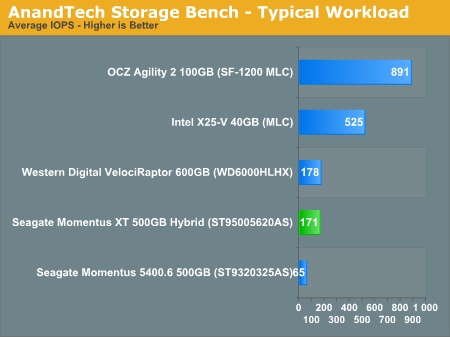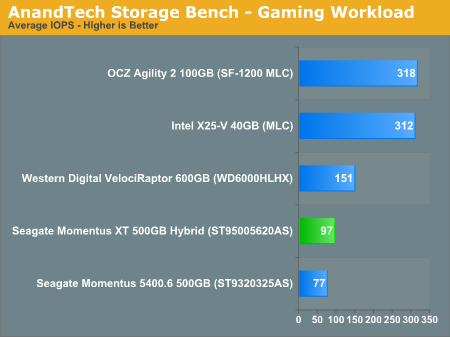Seagate's Momentus XT Reviewed, Finally a Good Hybrid HDD
by Anand Lal Shimpi on May 24, 2010 9:31 AM EST- Posted in
- Storage
- SSDs
- Seagate
- Momentus XT
- Hybrid Drive
- SSHDs
AnandTech Storage Bench
The first in our benchmark suite is a light usage case. The Windows 7 system is loaded with Firefox, Office 2007 and Adobe Reader among other applications. With Firefox we browse web pages like Facebook, AnandTech, Digg and other sites. Outlook is also running and we use it to check emails, create and send a message with a PDF attachment. Adobe Reader is used to view some PDFs. Excel 2007 is used to create a spreadsheet, graphs and save the document. The same goes for Word 2007. We open and step through a presentation in PowerPoint 2007 received as an email attachment before saving it to the desktop. Finally we watch a bit of a Firefly episode in Windows Media Player 11.
There’s some level of multitasking going on here but it’s not unreasonable by any means. Generally the application tasks proceed linearly, with the exception of things like web browsing which may happen in between one of the other tasks.
The recording is played back on all of our drives here today. Remember that we’re isolating disk performance, all we’re doing is playing back every single disk access that happened in that ~5 minute period of usage. The light workload is composed of 37,501 reads and 20,268 writes. Over 30% of the IOs are 4KB, 11% are 16KB, 22% are 32KB and approximately 13% are 64KB in size. Less than 30% of the operations are absolutely sequential in nature. Average queue depth is 6.09 IOs.
The performance results are reported in average I/O Operations per Second (IOPS):

Under typical multitasking workloads that aren't write intensive, the Momentus XT performs much like the new VelociRaptor. This isn't a typical notebook drive at all. We're still far away from even the cheapest SSDs though.
If there’s a light usage case there’s bound to be a heavy one. In this test we have Microsoft Security Essentials running in the background with real time virus scanning enabled. We also perform a quick scan in the middle of the test. Firefox, Outlook, Excel, Word and Powerpoint are all used the same as they were in the light test. We add Photoshop CS4 to the mix, opening a bunch of 12MP images, editing them, then saving them as highly compressed JPGs for web publishing. Windows 7’s picture viewer is used to view a bunch of pictures on the hard drive. We use 7-zip to create and extract .7z archives. Downloading is also prominently featured in our heavy test; we download large files from the Internet during portions of the benchmark, as well as use uTorrent to grab a couple of torrents. Some of the applications in use are installed during the benchmark, Windows updates are also installed. Towards the end of the test we launch World of Warcraft, play for a few minutes, then delete the folder. This test also takes into account all of the disk accesses that happen while the OS is booting.
The benchmark is 22 minutes long and it consists of 128,895 read operations and 72,411 write operations. Roughly 44% of all IOs were sequential. Approximately 30% of all accesses were 4KB in size, 12% were 16KB in size, 14% were 32KB and 20% were 64KB. Average queue depth was 3.59.

Crank up the sequential writes and you lose the benefit of the 4GB of SLC NAND on board the Momentus XT. It still delivers competitive performance with the X25-V thanks to the latter's limited write speeds, and it is faster than a conventional 2.5" drive as read operations still come off the NAND, but you don't get VelociRaptor performance out of it.
The gaming workload is made up of 75,206 read operations and only 4,592 write operations. Only 20% of the accesses are 4KB in size, nearly 40% are 64KB and 20% are 32KB. A whopping 69% of the IOs are sequential, meaning this is predominantly a sequential read benchmark. The average queue depth is 7.76 IOs.

As a benchmark that's bound by sequential read performance it's not surprising to see the Momentus XT not pull ahead here. Remember that we're limited by how quickly data can be streamed out of a single NAND device so you don't see a huge improvement in performance.










120 Comments
View All Comments
pkoi - Monday, May 24, 2010 - link
I have a 30gig SSD and haven't yet figured how to take advantage of it. OS and all program is above 100gig + 90% of It I don't read often.This is such a lost of NAND beyond 40 gig, I bet people with 80gig ssd don't read heavily on more than 30% of it's capacity.
About Time someone sort out for us, what file need to be on SSD and what doesn't.
x0rg - Monday, May 24, 2010 - link
I would add $50 to buy X25-M 80GB and $50 more for external 250GB WD Passport, and that would make me happier :) I'm already using X25-M in my desktop for about a year and I'm not going down for any hybrid, SSD only as a system drive.Fox5 - Monday, May 24, 2010 - link
All this seems to be doing in the same thing as the almost universally panned readyboost. Microsoft even had a spec for this called readydrive, and Intel had robson.If they enabled Readyboost on a PCIE or SATA drive, you could likely get this same performance (or better) by adding a low capacity SSD to your system. What would happen if you dedicated a small SSD to a pagefile btw? Does Windows persistently store page file information between boots, thus using it to speed boot times?
pkoi - Monday, May 24, 2010 - link
I'd also like an answer to this, What software is able to sort out the "to be cached files ?"mpx999 - Tuesday, May 25, 2010 - link
Not really. Seagate decides what to cache based on disk block level. This is much more universal approach than file-statistics-based readyboost, as it allows to cache most frequently used blocks from large files, like virtual machine virtual disks or those giant *.dat files of games. Readyboost is good to speed up access to lots of small files, like *.dll *.ini or small exe, but is no good for extracting most used blocks of large files.x0rg - Monday, May 24, 2010 - link
Could you add another regular Seagate Momentus 500GB hard drive 7200 rpm (not 5400)?That would be interesting to see if there is real difference between the regular HDD and the hybrid one.
skwareballz - Monday, May 24, 2010 - link
You said that power would be equal or lesser to most HDDs, and I was wondering if that was do to the power used x time taken to complete w/e? Most charts showed the power consumption higher than the 5400.6 which could be a pretty average notebook HDD, but the time to boot up and what-not were much lower for the H-HHD. Just trying to figure out if watts/sec average would be lower and allow more battery life?Thanks for the good review, too.
7Enigma - Monday, May 24, 2010 - link
Anand,I've been very pleased with your wait-and-see approach to most new technologies from the SSD front. So I was a bit shocked to see a glowing recommendation without the disclaimer to wait and see what happens in the next couple of months. This is potentially a great notebook drive (honestly for desktops a real SSD + mechanical HD is vastly superior but yes more expensive), but until we see some firmware updates and/or issues with the drive I think it should remain a recommendation with a major warning.
Thank you for the article; glad you're back!
Endoas - Monday, May 24, 2010 - link
Any idea how hot these things get compared to a traditional HDD or SSD? I don't see any tests regarding this issue.iwodo - Monday, May 24, 2010 - link
Currently 4GB is being limited simply because of Software problem ( 64Bit OS Required ) rather then Hardware, We can already make single stick 4GB DDR3 cheaply, only the market is not there yet. When 64Bit reaches tipping point, ( 1 - 2 years time ), 4GB System would be minimum with 8GB or even 16GB system. With So much RAM we could cache those Random Read Write Directly to RAM. Why would would need a Hybrid HDD?The Built in NAND Flash doesn't make any sense to me.